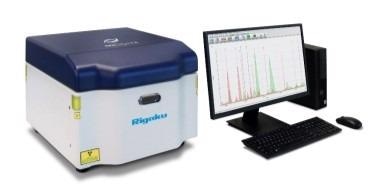Applied Rigaku Technologies announces NEX CG II, an indirect excitation EDXRF analyzer for enhanced elemental analysis for industrial quality control to advanced research applications
Applied Rigaku Technologies, Inc., a division of Rigaku Corporation, introduces NEX CG II, a powerful second-generation benchtop energy dispersive X-ray fluorescence (EDXRF) spectrometer. NEX CG II is a multi-element, multi-purpose analyzer that delivers rapid qualitative and quantitative elemental analyses and addresses needs across many industries. It provides non-destructive analysis of sodium to uranium in almost any matrix.

Rigaku NEX CGII Advanced Cartesian Geometry EDXRF Spectrometer
The Rigaku NEX CG II pushes the boundaries of EDXRF with its unique close-coupled Cartesian Geometry (CG) optical kernel and various new hardware upgrades. With the addition of a high-power X-ray tube, a high-performance large-area silicon drift detector and Rigaku’s advanced Fundamental Parameters software, the NEX CG II brings a new level of analytical sensitivity and ease-of-use to XRF technology.
NEX CG II serves a broad range of applications and industries and is an ideal tool for measuring ultra-low and trace element concentrations all the way up to percent levels.
It is easy to use for non-technical operators yet powerful enough for expert use in commercial labs and R&D facilities. Users can achieve the lowest limits of detection for elements in highly scattering matrices like water, hydrocarbons and biological materials. NEX CG II also features 3D optics, which dramatically increases the peak-to-background ratio. This results in a spectrometer capable of trace element analysis — even in challenging sample types.
NEX CG II excels in complex applications with trace elements and variable-base matrices, such as testing agricultural soils and plant materials, analyzing finished animal feeds, measuring waste oils, environmental monitoring, and many others.
Some of the key advantages and features that make NEX CG II an attractive proposition include:
- Non-destructive elemental analysis for sodium (Na) to uranium (U)
- Rapid elemental analyses of solids, liquids, powders, coatings, and thin films
- Indirect excitation for exceptionally low detection limits
- High-power 50 kV, 50 W X-ray tube
- Large-area high-throughput silicon drift detector (SDD)
- Analysis in air, helium, or vacuum
- Powerful and easy to use QuantEZ® software with multilingual user interface
- Advanced RPF-SQX Fundamental Parameters software featuring Scattering FP
- Rigaku Profile Fitting (RPF) advanced algorithm for peak deconvolution
- Various automatic sample changers accommodating up to 52 mm samples
- Low cost of ownership backed by a 2-year warranty

The Rigaku NEX CG II builds on NEX CG’s legacy of using full 90° Cartesian Geometry and secondary targets for trace level sensitivity. The new superior analytical power of the NEX CG II is provided by a 50 kV 50 W end-window palladium-anode X-ray tube, monochromatic or polarized excitation from five secondary targets, and a high-performance large-area silicon drift detector. This unique optical kernel, combined with Rigaku’s advanced RPF-SQX Fundamental Parameters software, delivers the most sensitive EDXRF measurements in the industry.
NEX CG II complements Rigaku’s existing range of benchtop and in-line process control EDXRF spectrometers. For more information about NEX CG II, visit https://rigakuedxrf.com/nex-cg.php